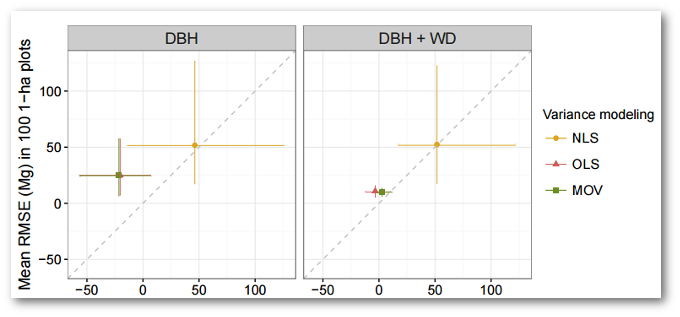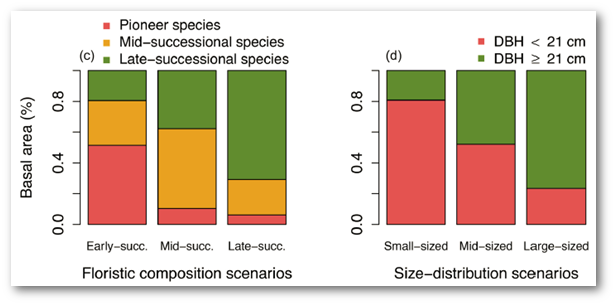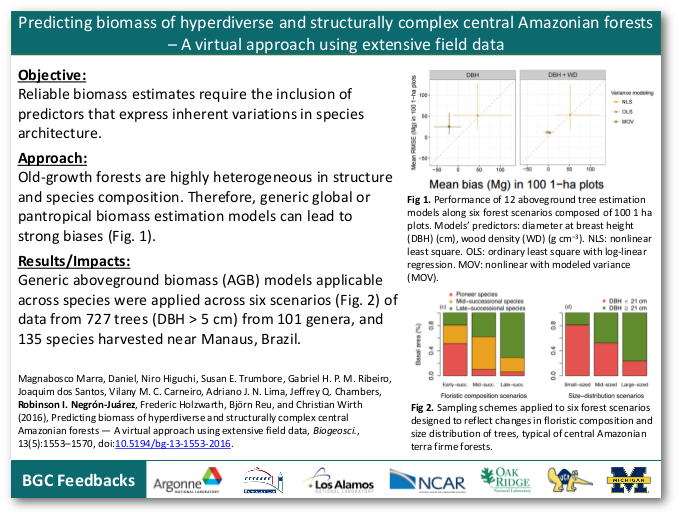Research Highlights
Predicting biomass of hyperdiverse and structurally complex central Amazonian forests — A virtual approach using extensive field data
March 11, 2016
Old-growth forests are subject to substantial changes in structure and species composition due to the intensification of human activities, gradual climate change and extreme weather events. Trees store ca. 90% of the total aboveground biomass (AGB) in tropical forests and precise tree biomass estimation models are crucial for management and conservation. In the central Amazon, predicting AGB at large spatial scales is a challenging task due to the heterogeneity of successional stages, high tree species diversity and inherent variations in tree allometry and architecture. We parameterized generic AGB estimation models applicable across species and a wide range of structural and compositional variation related to species sorting into height layers as well as frequent natural disturbances. We used 727 trees (diameter at breast height ≥5 cm) from 101 genera and at least 135 species harvested in a contiguous forest near Manaus, Brazil. Sampling from this data set we assembled six scenarios designed to span existing gradients in floristic composition and size distribution in order to select models that best predict AGB at the landscape level across successional gradients. We found that good individual tree model fits do not necessarily translate into reliable predictions of AGB at the landscape level. When predicting AGB (dry mass) over scenarios using our different models and an available pantropical model, we observed systematic biases ranging from −31% (pantropical) to +39%, with root-mean-square error (RMSE) values of up to 130 Mg ha−1 (pantropical). Our first and second best models had both low mean biases (0.8 and 3.9%, respectively) and RMSE (9.4 and 18.6 Mg ha−1) when applied over scenarios. Predicting biomass correctly at the landscape level in hyperdiverse and structurally complex tropical forests, especially allowing good performance at the margins of data availability for model construction/calibration, requires the inclusion of predictors that express inherent variations in species architecture. The model of interest should comprise the floristic composition and size-distribution variability of the target forest, implying that even generic global or pantropical biomass estimation models can lead to strong biases. Reliable biomass assessments for the Amazon basin (i.e., secondary forests) still depend on the collection of allometric data at the local/regional scale and forest inventories including speciesspecific attributes, which are often unavailable or estimated imprecisely in most regions.
Objective
Reliable biomass estimates require the inclusion of predictors that express inherent variations in species architecture.
Approach
Old-growth forests are highly heterogeneous in structure and species composition. Therefore, generic global or pantropical biomass estimation models can lead to strong biases (Fig. 1).
 |
Fig 1. Performance of 12 aboveground tree estimation models along six forest scenarios composed of 100 1 ha plots. Models’ predictors: diameter at breast height (DBH) (cm), wood density (WD) (g cm−3). NLS: nonlinear least square. OLS: ordinary least square with log-linear regression. MOV: nonlinear with modeled variance (MOV). |
Results/Impacts
Generic aboveground biomass (AGB) models applicable across species were applied across six scenarios (Fig. 2) of data from 727 trees (DBH >5 cm) from 101 genera, and 135 species harvested near Manaus, Brazil.
 |
Fig 2. Sampling schemes applied to six forest scenarios designed to reflect changes in floristic composition and size distribution of trees, typical of central Amazonian terra firme forests. |
Magnabosco Marra, Daniel, Niro Higuchi, Susan E. Trumbore, Gabriel H. P. M. Ribeiro, Joaquim dos Santos, Vilany M. C. Carneiro, Adriano J. N. Lima, Jeffrey Q. Chambers, Robinson I. Negrón-Juárez, Frederic Holzwarth, Björn Reu, and Christian Wirth. March 11, 2016. “Predicting Biomass of Hyperdiverse and Structurally Complex Central Amazonian Forests — A Virtual Approach Using Extensive Field Data.” Biogeosci., 13(5):1553–1570. doi:10.5194/bg-13-1553-2016.
